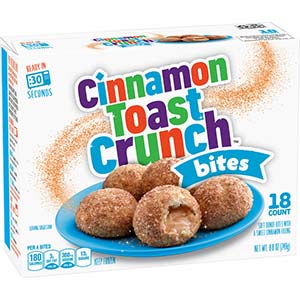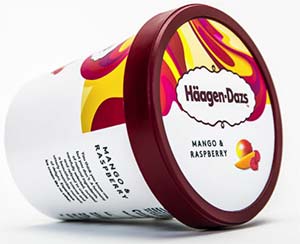 Wanchai Ferry brand Sea Cucumber Shrimp Dumplings was among a raft of new products promoted by General Mills during its Investors Day event at the New York Stock Exchange on July 12. The premium wonton wrapped seafood delicacy is distributed frozen in 600-gram packs to retail customers in the China market.
Wanchai Ferry brand Sea Cucumber Shrimp Dumplings was among a raft of new products promoted by General Mills during its Investors Day event at the New York Stock Exchange on July 12. The premium wonton wrapped seafood delicacy is distributed frozen in 600-gram packs to retail customers in the China market.
While General Mills is widely known for flour, breakfast cereals, cake mix, ambient snack foods, yogurt and granola bars, among its well recognized frozen products in addition to Wanchai Ferry fare are Häagen-Dazs ice cream, Cascadian Farm organic vegetables, Totino’s pizza and Jeno’s pizza rolls.
 In the USA and Canada, Cinnamon Toast Crunch Bites, now available in the frozen food sections of supermarkets and grocery stores, are ready to serve after just 30 seconds of microwave oven zapping. Eighteen bites come per 249-gram pack.
In the USA and Canada, Cinnamon Toast Crunch Bites, now available in the frozen food sections of supermarkets and grocery stores, are ready to serve after just 30 seconds of microwave oven zapping. Eighteen bites come per 249-gram pack.
Also in the USA retail market General Mills’ Pillsbury’s Best Pizza Dough has succeeded in taking the dough out of the can. The new offering, available in Classic and Thin Crust versions, is individually rolled in clear parchment paper to make it easy to unroll, top and bake.
“Regardless of the changing consumer landscape, one thing remains consistent: people still want great-tasting products. We’re increasing our levels of innovation across the board, with a laser focus on delivering exceptional taste with simple ingredients – whether it’s pioneering new innovation like French-style yogurt in the United States or Häagen-Dazs Mini Stick bars in Europe,” said Jeff Harmening, chief executive officer of the Minneapolis, Minnesota-headquartered diversified food company.
 In Europe, Australia and Asia, Häagen-Dazs Mini-Stick ice cream bars have been “reduced in size for guilt-free indulgence.” The new five-packs contain Salted Caramel, Vanilla Caramel Almond, and Chocolate Almond flavors.
In Europe, Australia and Asia, Häagen-Dazs Mini-Stick ice cream bars have been “reduced in size for guilt-free indulgence.” The new five-packs contain Salted Caramel, Vanilla Caramel Almond, and Chocolate Almond flavors.
In France and Spain the Häagen-Dazs Frozen Yogurt pint and mini-cups collections come in plain, strawberry and macadamia nut.
Häagen-Dazs Renaissance
 Laura Knutson of the General Mills’ communications department called the “Häagen-Dazs renaissance” a global refresh that “encompasses everything from packaging to advertising to the shop experience, and reflects the brand’s status as a leader in super-premium ice cream and more broadly, an international lifestyle icon.”
Laura Knutson of the General Mills’ communications department called the “Häagen-Dazs renaissance” a global refresh that “encompasses everything from packaging to advertising to the shop experience, and reflects the brand’s status as a leader in super-premium ice cream and more broadly, an international lifestyle icon.”
So why a branding refresh, and why now?
She put the questions to Jennifer Jorgensen, vice president and marketing director of Häagen-Dazs in the United Kingdom, who said straightaway that a key part of the strategy is to make sure the brand remains relevant – especially among today’s millennial generation consumers.
 “Globally, before we did this brand refresh, consumers universally would say: ‘We love Häagen-Dazs, we love the product, but could you please change the packaging?’” stated Jorgensen. “Consumers wanted to stay with us because we are on trend…with the simple, real ingredients and high indulgence. But it’s just the branding side of it that they felt didn’t represent them.”
“Globally, before we did this brand refresh, consumers universally would say: ‘We love Häagen-Dazs, we love the product, but could you please change the packaging?’” stated Jorgensen. “Consumers wanted to stay with us because we are on trend…with the simple, real ingredients and high indulgence. But it’s just the branding side of it that they felt didn’t represent them.”
Colorful, worldly, and fun, the Häagen-Dazs brand refresh includes updated packaging designed by more than a dozen up-and-coming artists, including Bob Sanderson.
Four Decades of History
Since its first retail shop opened in New York City during 1976, Häagen-Dazs has become a global symbol for luxury ice cream. People in 90 countries consume 744 million scoops per annum, and this year Häagen-Dazs entered five new national retail markets: Australia (which has one of the higher ice cream consumption rates in the world), the Netherlands, Romania, Bulgaria and Serbia.
“We wouldn’t be successful without the history of the brand,” said Olivier Faujour, president of the General Mills dairy strategic brand unit, which includes the international Häagen-Dazs business. “Häagen-Dazs was created with the powerful vision that food should be simple, natural and made from high-quality ingredients. That brand equity has allowed us to innovate – and stay fresh and contemporary with marketing – while forever paying tribute to our roots.”
Product innovation is the other aspect driving continued success outside North America. “Impulse” ice cream is the largest and fastest-growing segment of the category worldwide. Häagen-Dazs is the forefront of this segment with its on-the-go treats such as ice cream stick bars and the new mini stick bars.
“Consumers are no longer pacing out their eating occasions throughout the day, and they’re more doing a lot of grazing, or ‘If I want a treat, I’m going to have it right now’ behavior. So an impulse, something that doesn’t need a spoon, is more suited to that,” said Jorgensen.
New York Takeaways
During the Investors Day event in New York, Christina Law, General Mills group president for Asia and Latin America, touched on trends in those markets. Among growth drivers for Häagen-Dazs in Asia are limited edition fruit and flower combination flavors such as Rose Raspberry & Lychee and Elderflower & Black Currant, she said. Also popular are Toffee Mochi Ice Cream and Yazu Citrus & Cream offerings.
New frozen Pizza Roll innovations, Grab & Go Pizza Sticks and Cheesy Chicken Stuffed Nachos are among the Totino’s brand innovations in the pipeline for fiscal 2018, reported Jon Nudi, group president for North America Retail operations.
“We’ll remain laser-focused on knowing our consumer and what’s driving them,” said CEO Harmening, who assumed the helm on June 1. “While the biggest shift in our industry in the last five years was driven by changing consumer food values, I believe the most significant change that will impact the next five years will be in how consumers get their food, driven by the rapid acceleration of e-commerce. We see this as an exciting opportunity for General Mills.”
E-commerce represents about 1.5% of the company’s total sales in the USA today. General Mills expects this number to grow to 5% by 2020. It also continues to see strong double-digit growth ahead for the global e-commerce business, led by sales in the United States.
The company generated fiscal 2017 consolidated net sales of $15.6 billion, as well as another $1.0 billion from its proportionate share of joint-venture net sales. Retail sales in the North American market accounted for approximately two-thirds of total revenues, at $10.2 billion.





